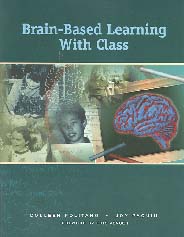|
________________
CM . . . .
Volume VII Number 12 . . . . February 16, 2001
excerpt: MemoryBrain-Based Learning with Class is an innovative workbook that addresses discoveries in brain research and that is designed to help teachers develop brain based teaching strategies. After the introduction, the authors analyse the brain, both in terms of its parts and its functioning. From a physiological perspective, issues such as emotional state, nutrition, individual differences, brain body coordination, memory and stress are reviewed. Part 2 makes suggestions about ways that students could be taught about the brain, starting with "What's in it for me" and how is the brain like...a cabbage, a raisin, grapefruit, etc.; and Part 3 reviews a myriad of classroom activities focussing on the topics studied earlier. For example, in the discussion of the change of state, all sorts of activities are reviewed which could change the emotional temperament of a room. Part 4 offers suggestions for assessing ourselves and our learning. The book ends with very clear black line masters that can be reproduced. After a general overview of the physiology of the brain, the authors introduce readers to many practical classroom strategies, based on the theories introduced earlier. The detailed table of contents is very helpful and the bibliography includes a separate children's book list. Sections begin with memorable quotes related to the topic and many very clear diagrams are useful in understanding the functioning of the brain. This book is a teacher's resource and provides a clear view as to why the strategies suggested in quantum learning strategies work. Highly Recommended. Meredith MacKeen is the teacher-librarian at Glen Stewart School in Stratford, PEI.
To comment on this title or this review, send mail to cm@umanitoba.ca.
Copyright © the Manitoba Library Association.
Reproduction for personal use is permitted only if this copyright notice
is maintained. Any other reproduction is prohibited without
permission.
Published by
TABLE OF CONTENTS FOR THIS ISSUE - February 16, 2001.
AUTHORS |
TITLES |
MEDIA REVIEWS |
PROFILES |
BACK ISSUES |
SEARCH |
ORDER |
CMARCHIVE |
HOME
|
